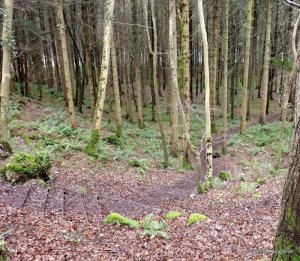Another of the hidden gems I’ve found in Ireland is Dooney Rock, located on the R287 from Sligo to Dromahaire.
Dooney Rock was made famous by W.B. Yeats in his poem ‘The Fiddler of Dooney’. In the poem Yeats tells the story of an Irish fiddler who expresses himself though his music. The townland of ‘Kilvarnet’ which is referred to in the poem is a small parish near Collooney.
When you find it, there is a car park with a picnic area, and leading from there is a nature trail that loops around this wooded wonderland. The path initially leads to the edge of Lough Gill, before heading towards the top of Dooney Rock.
The trail leads through the woods and along the water edge; no matter which way you go there is always a beauty to be seen. As you walk along the shoreline there are views across Lough Gill. These photos were taken in February, and I love the starkness of the winter trees against the water and the distant mountains. It was also a wonderfully calm day, so the reflections in the water were great to capture.
At regular intervals along the path, there benches that give the chance to sit and relax and there are also information posts giving details on the various trees and plants located in the area.
The path actually follows a figure eight loop; I returned to the edge of Lough Gill by the path through the forest. There were loads of old tree stumps which to me resembled strange creatures frozen in wood.
There are little gems around each corner; I loved the little stream that trickles into the lough, and the moss covered boulders along the edge of Lough Gill.
When you reach the top of Dooney Rock itself there are views of the two mountains which dominate the Sligo landscape; Benbulben and Knocknarea.
Benbulben is probably the mountain most associated with Sligo, and is part of the Dartry range of mountains.
The name is an Anglicization of the Irish name “Binn Ghulbain”. “Binn” means peak or mountain, while “Ghulbain” refers to Conall Gulban, a son of Niall of the Nine Hostages. Another translation is jaw-shaped peak.
Knocknarea is reputed to be the burial site of Queen Maeve of Connaught. You might just be able to make out the cairn on the top of the mountain.
The name is also anglicized from “Cnoc na Riabh” (meaning “hill of the stripes”). However, another interpretation is “Cnoc na Riaghadh” (“hill of the executions”).
This was another great chill out place to visit; it’s quite close to Sligo town, but to me it gives that feeling of quiet stillness. If you’re in the area have a look!
Information for Knocknarea and Benbulben taken from Wikipedia.















